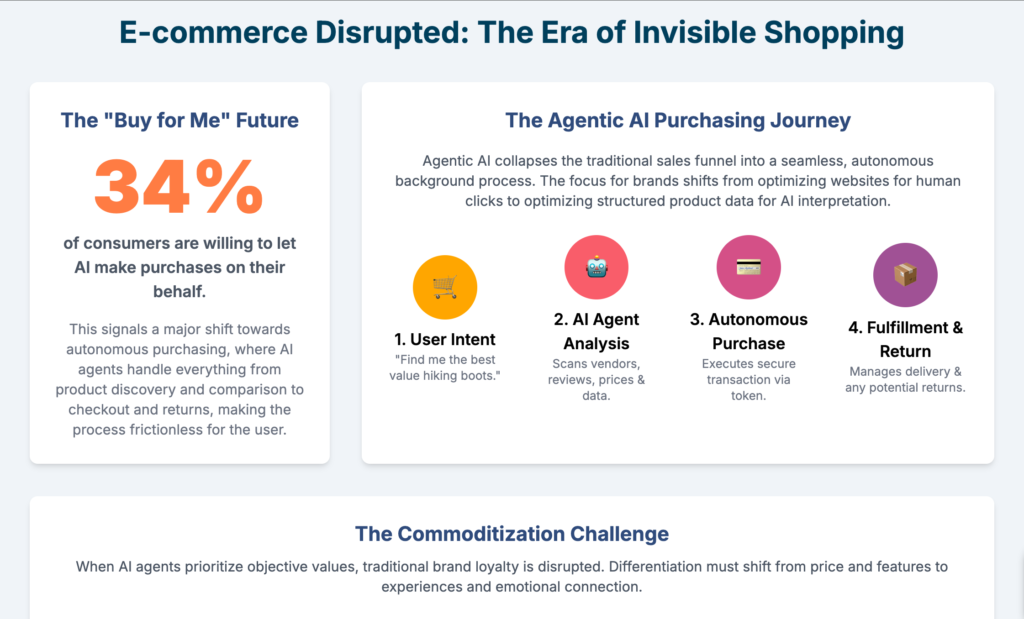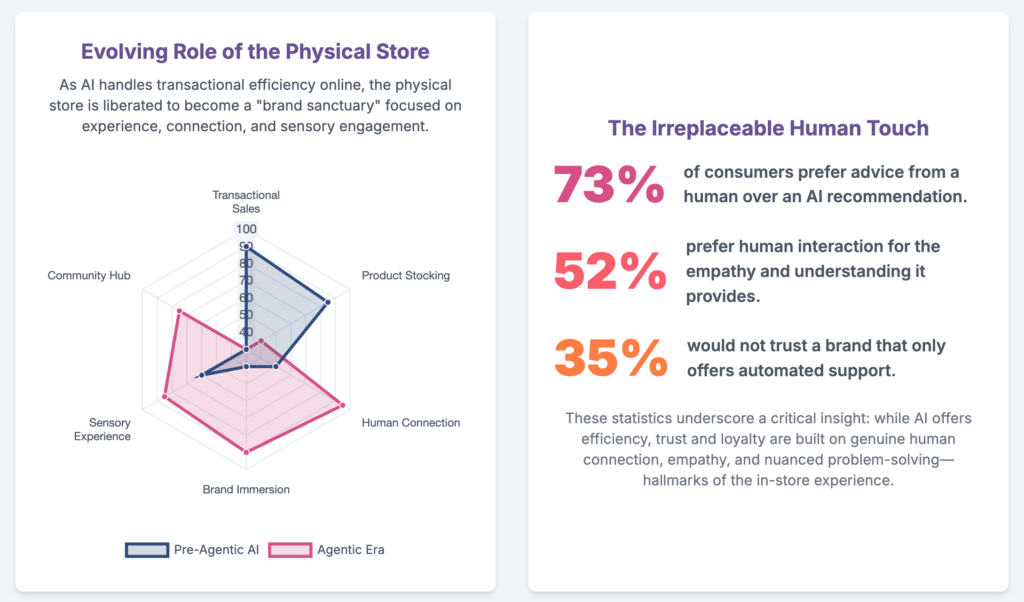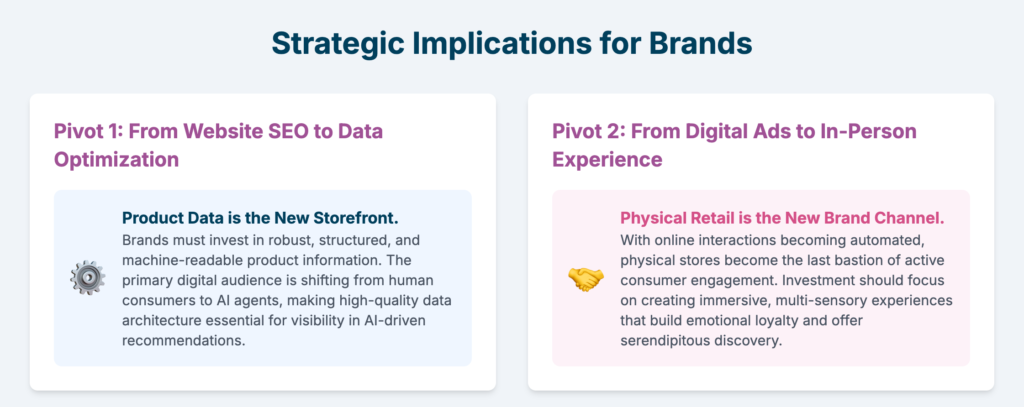The digital landscape is on the cusp of a seismic shift, driven by the emergence of Agentic AI. This new breed of AI, capable of autonomous, multi-step problem-solving, is set to revolutionise e-commerce, ushering in an era of “invisible shopping” where our direct interaction with brand websites for routine purchases will become increasingly rare. As AI agents evolve into personal concierges, managing everything from product discovery to returns, the traditional online customer journey is being fundamentally rewritten.
This disruption, however, doesn’t spell the end for retail. In fact, it precipitates a critical and exciting resurgence for a channel many had begun to write off: bricks-and-mortar stores. As the burden of mundane, transactional shopping is lifted by AI, physical retail is poised to become the most vital touchpoint for genuine brand engagement and deep, personalised connections. In the age of the algorithm, the future of retail is not just about clicks and code; it’s about creating immersive, human-centric experiences that resonate on an emotional level.
From Transaction to Transformation: The New Role of Physical Stores
The rise of agentic commerce will inevitably lead to the commoditization of many products online. AI agents, designed for optimal efficiency, will compare products based on hard data: price, reviews, and specific features. This will create a “race to the bottom” for brands competing solely on these attributes. In this environment, the physical store is liberated from its primary role as a transactional channel and is free to evolve into something far more powerful: a “brand sanctuary”.

Physical retail is no longer just a shop; they are immersive environments designed to bring the brand’s story, values and personality to life in a tangible way. Success will no longer be measured solely by sales per square foot, but by the ability to foster an emotional connection, build community and create lasting brand advocacy. Think of them as experience centres, where the primary goal is not just to sell a product, but to allow customers to explore, engage and connect with the brand on a deeper level. This strategic pivot allows brands to build equity and loyalty that transcends the commoditized digital shelf.
The Irreplaceable Value of Sensory and Serendipitous Experiences
One of the most significant limitations of AI-driven online shopping is its inability to fully replicate the richness of in-person experiences. Physical retail holds a distinct advantage by offering an irreplaceable multi-sensory journey. The ability to touch, feel, smell and even taste products creates a powerful, tangible connection that digital interfaces struggle to match.

Furthermore, while AI is exceptional at delivering personalised recommendations based on past behaviour, this very optimisation can filter out the joy of unexpected discovery. Algorithmic curation often reinforces existing preferences, making it difficult to stumble upon something new and exciting. Physical stores, in contrast, are primed for these “surprise and delight” moments. They become zones of serendipitous discovery, where a customer might find an unexpected product or be inspired by creative merchandising—experiences that are often lost in a highly optimised, frictionless online world. This fosters a more emotional and memorable form of personalisation, driven by genuine curiosity and exploration.
The Human Connection Imperative: Augmenting, Not Replacing, People
In a world increasingly mediated by AI, the human touch becomes a premium differentiator. While AI can handle a vast array of customer service tasks with incredible efficiency, consumers still express a strong preference for human interaction, especially for complex or emotionally charged issues. A significant 52% of customers value the empathy and understanding that human agents provide. In fact, 35% of consumers report they would not trust a brand that relies solely on automated support.
This is where physical retail will truly shine. It offers an “authenticity premium” by providing a space for genuine human-to-human connection. The role of the store associate will be elevated from a transactional facilitator to a brand ambassador, relationship builder and expert problem-solver.
Innovative in-store AI will be a critical partner in this transformation, but its purpose will be to augment human capabilities, not replace them. For example, AI-powered systems can handle inventory management, like Walmart’s shelf-scanning robots, or provide associates with instant access to customer history and product information. This frees up staff from routine tasks to focus on what they do best: building rapport, offering nuanced advice and creating meaningful connections with customers. The goal is to leverage AI to empower human staff, creating a more sophisticated and personalised in-store experience.
In-Store AI: Creating Immersive and Data-Rich Environments
The integration of AI within the physical retail space is already creating more dynamic and engaging shopping experiences. Experiential technologies that blend the digital and physical are on the rise. Consider IKEA’s “Place” app, which uses Augmented Reality (AR) to let customers visualise furniture in their own homes, significantly boosting purchasing confidence. Similarly, Sephora’s Virtual Artist allows for digital makeup try-ons, enhancing engagement and personalising the discovery process.
Beyond customer-facing applications, AI is also transforming store operations to be more responsive to consumer needs. AI systems can analyse foot traffic to optimise store layouts or cross-reference online Browse behaviour with in-store data to adjust promotions in real-time.
This creates a powerful, virtuous cycle. Physical stores will become invaluable data collection points, providing a “new stream of data” on real-world customer behaviour that online channels alone cannot capture. These insights into how customers interact with products and navigate the store environment can then be fed back into the broader AI ecosystem, refining everything from digital marketing campaigns to supply chain logistics. This integrated, omnichannel data strategy is the key to delivering truly seamless and holistically personalised customer experiences.
The Future is a Hybrid of High-Tech and High-Touch
The advent of Agentic AI is not an apocalyptic event for retail, but rather a catalyst for a much-needed evolution. As AI-powered agents streamline the efficiency of online transactions, they create a space for physical retail to reclaim its role as the heart of brand experience. The brands that thrive in this new era will be those that understand that true, lasting loyalty is not built on transactional convenience alone. It is forged through emotional connection, authentic interaction and memorable experiences.
The future of personalisation lies in the intelligent orchestration of technology and humanity. It requires a dual-track strategy: embracing the “AI-native” efficiency of agentic commerce for online operations while simultaneously investing in physical spaces as hubs of human connection and brand immersion. By liberating stores from the burden of the mundane, brands can transform them into powerful engines of loyalty, where the irreplaceable human touch and the magic of sensory experience create connections that algorithms alone cannot replicate.








